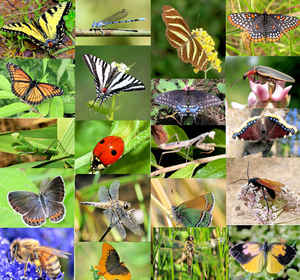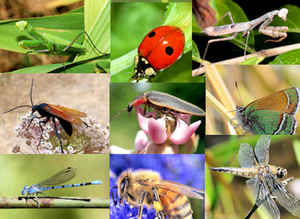
South Carolina Symbols
South Carolina State Insect
Carolina Mantid

(Stagmomantis carolina)
Adopted in 1988.
The Carolina mantid, {Stagmomantis carolina (Johannson),} a praying mantis, was designated South Carolina State Insect by the General Assembly by Act No. 591 of 1988, for the following reasons: it is a native, beneficial insect that is easily recognizable throughout the State; it symbolizes the importance of the natural science of entomology and its special role in all forms of agriculture in helping to control harmful insects; and it provides a perfect specimen of living science for the children of this State.
South Carolina State Insect: Carolina Mantid

The Carolina Mantid grows up to be about 4-7 cm in length with a large head and abdomen. They have a pair of large forelegs that are serrated and spiny and folded back like a "pocket knife." The body color is a tannish-brown with wings that are light green. They hold their forelegs up in a "praying" position to grab prey. Adult males are smaller and more slender than females, and have longer wings (Teyssier 1997; Lyon 2000; Lutz 1948).
Characteristics of the Carolina Mantid
Food Habits
The Carolina Mantid usually uses a "sit-and-wait" tactic of obtaining its prey. It waits quietly, and attacks any insects that come near, grabbing them with it's forelegs. Often it will wait near a flower and attack the insects that come to the flower to feed. Occasionally mantids will stalk prey, but this is not common. Ants are one of the prey types that S. carolina will sometimes chase (Preston-Mafham 1993). This species, like all mantids, is cannibalistic. Mantid nymphs and adults will eat other (Hurd 1999).
Reproduction
Stories of mantid cannibalism during mating are well known, but frequently exagerated. Female mantids do sometimes attack and eat males during courtship or mating. This kind of cannibalism in Stagmomantis carolina has only been observed scientifically in the laboratory, and it is not known whether it occurs in natural conditions. It is partly a function of female hunger: well-fed females are much less likely to attack their mates. The voracious hunger of mantids is no surprise - each female will produce one or more egg pods, each of which weighs about a third of her body weight. She needs a lot of food to make that reproductive effort, and male mantids are one of the largest and most easily acquired prey around her.
Females lay their eggs in a case formed from a liquid foam secreted from abdominal glands. The foam quickly hardens to form a protective shell. In temperate North America, all adult mantids die in the winter, and only the eggs survive to the following spring. There is one report of overlapping generations of S. carolina occuring in Florida (Price 1984, Prete et al 1999).
The first instar nymphs are orangish with brown-banded knees. The second thru fourth instars are usually a series of unpretentious uniform greens,
tans or browns. They then start phasing into the coloration of the adult. The female's abdomen starts widening in the last three instars while the
male's stays thin. Both sexes are quite active until the last few instars, when the female's start becoming more sedentary.
Behavior
Mantids are ordinarily very sedentary, and may spend their whole lives on one tree or in a single meadow. They will stay in one place as long as there is a good supply of food. In late summer males start to move around more, looking for potential mates. Males fly more than females, usually at night (Hurd 1999)
Mantids have "ears" on their bodies that can detect high-frequency sounds like those used by bats to hunt, and a flying mantid will land or change its flight pattern if it hears such sounds (Yager 1999).
Habitat
The Carolina Mantid lives in almost any location, from heavy woods to marsh to grasslands. As one might expect, the coloration dominant in any given location matches the vegetation of that location. Grasses and leafy weed rows will yield more green specimens while the woods will yield mostly bark mimics.
South Carolina Law
The law designating the Carolina mantid as the official South Carolina state insect is found in the South Carolina Code of Laws, Title 1, Chapter 1, Article 9, Section 1-1-645.
Title 1 - Administration of the Government
CHAPTER 1. GENERAL PROVISIONS
ARTICLE 9. STATE EMBLEMS, PLEDGE TO STATE FLAG, OFFICIAL OBSERVANCES
SECTION 1-1-645.
SECTION 1-1-645. Official State insect.
(A) The Carolina mantid, Stagmomantis carolina (Johannson) , or praying mantis, is the official insect of the State.
(B) A statement in substantially the following form must be printed in the next edition and all subsequent editions of the South Carolina Legislative
Manual in the appropriate section:
The State Insect
The Carolina mantid, Stagmomantis carolina (Johannson), or praying mantis, was designated the state insect by the General Assembly by Act 591 of 1988,
for the following reasons: it is a native, beneficial insect that is easily recognizable throughout the State; it symbolizes the importance of the
natural science of entomology and its special role in all forms of agriculture in helping to control harmful insects; and it provides a perfect specimen
of living science for the school children of this State.
Taxonomic Hierarchy: Carolina Mantis
Kingdom: Animalia (Animals)
Phylum: Arthropoda (Arthropods)
Subphylum: Hexapoda (Hexapods)
Class: Insecta (Insects)
Order: Mantodea (Mantids)
Family: Mantidae
Genus: Stagmomantis
Species: carolina (Carolina Mantis)
Butterflies, and Bugs







